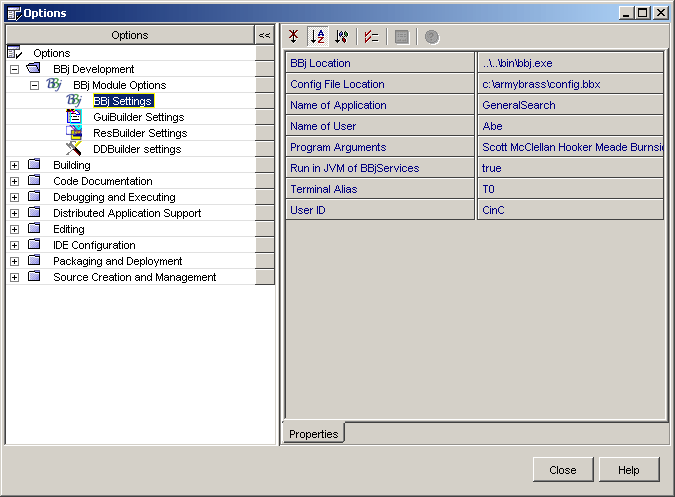Configuring the BBj Debugger
Before the BBj Debugger can be used in the IDE, there are BBj module settings that should be checked in the Options window. The Options window is opened by selecting Tools | Options from the main menu. In the Options window, expand the BBj Development | BBj Module Options hierarchy and select BBj Settings as shown in the image below. The Properties tab in the right side of the Options window displays all the configurable properties that affect executing or debugging a BBj program in the IDE. After the initial installation of the IDE, these properties are loaded with default values that may need to be changed to fit your particular situation. To edit or change a property, click on its value with the right mouse button.

The BBj Settings properties are used only when a BBj program is executed or debugged in the IDE. They are not required for opening a BBj file in the Source Editor. Remember that these options are global, rather than specific to a particular project. BASIS anticipates that a future version of NetBeans will allow stronger support for project-specific options settings.
The BBj Location and Config File Location properties tell the IDE where to find the BBj executable and config file on the system. By default, these properties are set to relative paths based on the <installation directory>/netbeans/bin directory. These may be changed to different relative or absolute paths pointing to other locations as necessary.
The Name of Application and Name of User properties correspond to the -a and -n command line arguments. Entering an application name and/or user name will allow a custom BBj SysWindow configuration file to be used in place of BBjSysWindowDefault.def. By default, these two properties are empty.
Program Arguments are space-delimited arguments that will be passed to the BBj program being executed or debugged in the IDE. These arguments can be accessed programmatically using the ARGV() function. By default, this property is empty.
Run in JVM of BBjServices is a boolean property applying only to executing BBj programs in the IDE. If set to 'true', then the BBj program will be run in the same Java virtual machine (JVM) as BBjServices. If set to 'false', then the program will instead begin execution as a new thread inside the same JVM used by the IDE itself. By default, this property is set to 'true'. When a BBj program is debugged in the IDE, it always executes in the same JVM as the IDE, regardless of the setting of the Run in JVM of BBjServices property.
The Terminal Alias property corresponds to the -t command line argument and specifies a default terminal device alias from the config file. By default, this property is set to T0.
The User ID property corresponds to the -u command line argument and specifies the user account to be used for data server access. By default, this property is left empty.